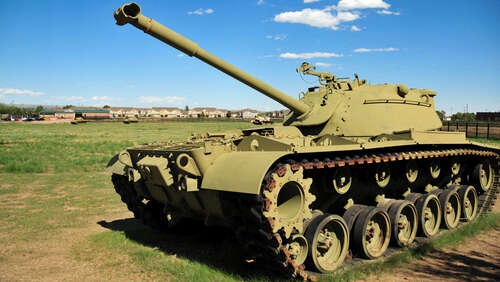
The M48 Patton marked a significant step in the evolution of the series, and was to be the most successful Patton tank so far. Like the M47, it also suffered teething problems, but these were justifiable, given its numerous innovations and improvements. They included an engine overhaul and a more powerful main cannon, a single central driver position, and a yoke that replaced the previous lever-based steering system. Composite materials, which offered better protection, were applied to the armor, and a more advanced fire control system combined an improved rangefinder with a ballistic computer that calculated the optimum firing solution.
With no requirement for an assistant driver, the M48 Patton had one fewer crew member and one fewer machine gun than its predecessors, comprising a 90-millimeter main gun and single .50-caliber and .30-caliber machine guns. It measured over 30 feet in length by 12 feet wide and was over 10 feet in height. Its armor plating was thicker than the M47’s at 110 millimeters, and at almost 50 tons in weight, it could muster speeds of up to 30 miles per hour. Initially, the M48’s range was just 70 miles, until the addition of external fuel tanks mounted at the rear gave it a maximum range of 135 miles.
Three more variants were made: the M48A1, M48A2, and M48A3, each with various improvements on the last. Chrysler was initially awarded the contract, with a production target of 3,000 units per year over three years. However, complications with the transmission, engine, and suspension slowed progress. Eventually, around 12,000 M48 variants were built throughout its production run, with Ford, General Motors, and the Fisher Tank Arsenal also joining in its manufacture.
[Featured image by Arcticseahorse via Wikimedia Commons | Cropped and scaled | CC BY-SA 4.0]

